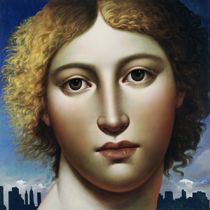
"The City 9"
Oil on Canvas
2002

|
|
||||
|
|
"Carlo Maria Mariani is an avant-garde artist, but of a unique cast: he
believes in classical beauty, beauty as an infinitely repeatable ideology
which he has decided - with exquisite timing - to repeat, in order to
give art the solid center of gravity it seems to have lost. Beauty is
always radical, that is, it is the esthetic root of art. At the time of
his return to beauty - well before the Transvanguardia movement - avant-garde
art was indifferent to it..."
- Donald Kuspit, Idiosyncratic Identities: Artists at the End of the Avante-Garde
"(Mariani's) work is not merely pretty pictures; it also exerts a
considerable appeal to the intellect through a set of references to Modern
and Classical motifs and styles which interact in a variety of controlled
significations."
- Thomas McEvilley, The Exile's Return: Toward a Redefinition of Painting for the Post-Modern Era
"On large scale, Carlo Maria Mariani creates enigmatic scenes of
classical nudes juxtaposed with absurd details. His paintings are beautifully
conceived...[he] situates his elegant Greco-Roman figures in ludicrous
and disturbing circumstances...The artist thus reveals his 'hand' in painted
artifice and once again startles us with the unforeseen."
- Mary Schneider Enriquez, Artnews
"In the 1960's, [Mariani's] art was influenced by both hyperrealism
and conceptualism: a decade later, Mariani began quoting from masterworks
of antiquity, a tendency that later evolved into his signature, exalted-eerie
style. For the mood of Mariani's pictures can be as cool as their allegorical
drama is high-pitched, sometimes exuding the hushed, airless
atmosphere of classic surrealism."
-Edward Gomez, Art & Antiques
"...Mariani conjures a sempiternal realm that exists parallel to
mundane reality and which is accessible through art, reverie and the imagination."
- Gerard McCarthy,
Art in America
"Communicating by means of a personal
iconographic system steeped in mythology and classical ideals. Mariani
fuses the past with the present in order to illuminate a sometimes unsettling,
but always exhilarating future. He evokes the hushed serenity of antiquity
and the cacophonous turbulence of modernism, which momentarily in the
paintings at least, have reached tentative accord...Mariani's aim is not
to reconstruct the ancient world, nor does he present a fragmentary view
of it, in the form of romantic moss-covered ruins and the like...He embraces
myth as a language which he finds best suited to express his most complex
emotions...For Mariani, myth is an attitude and response to the world
around him, rather than simply means to explicate or reiterate the lessons
of antiquity."
- David Ebony, from the book, Carlo
Maria Mariani